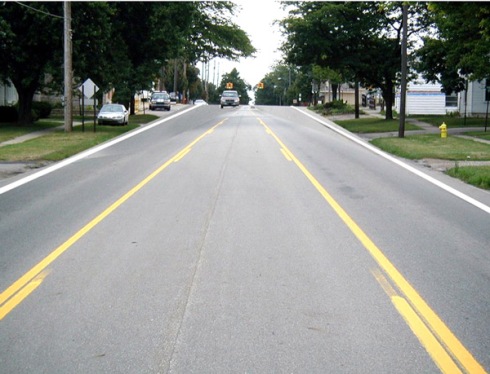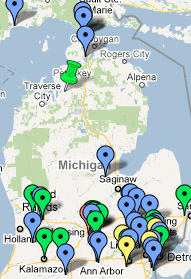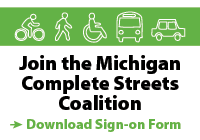By Holly Madill, Complete Streets Project Coordinator - Michigan Department of Community Health

 Recent preliminary research from Paul Hamilton, Tri-County Regional Planning Commission, and Dave Morena, Federal Highway Administration (FHWA) Division Office suggests that Michigan could be the national leader in road diets and having road diet supportive policies in place. Analysis of in-state existing and planned 4 to 3 lane conversions (road diets) yields some early and impressive results:
Recent preliminary research from Paul Hamilton, Tri-County Regional Planning Commission, and Dave Morena, Federal Highway Administration (FHWA) Division Office suggests that Michigan could be the national leader in road diets and having road diet supportive policies in place. Analysis of in-state existing and planned 4 to 3 lane conversions (road diets) yields some early and impressive results:
- The Tri-County region (Clinton, Eaton, Ingham) has completed 15 miles of conversion from 4 to 3 lanes. An additional 18.5 miles of conversions are planned by 2035.
- The Genesee County Metropolitan Planning Commission has completed approximately 19.5 miles and released a 2009 Complete Streets technical report that depicts many more by 2035.
- The Michigan Department of Transportation has completed at least 45 miles of road diets on state trunklines around the state.
Hamilton and Morena have surveyed state DOT’s and regional transportation authorities across the country and found few places that compare to these numbers. Add in that Michigan has adopted Complete Streets laws and also has the highest number of local communities that have adopted Complete Streets policies, and one can quickly come to the conclusion that Michigan is becoming a progressive, national leader in active transportation.
Both the Michigan DOT and the FHWA Michigan Division office have stated that 4 to 3 lane conversions are operationally safe for roads with average daily traffic (ADT) or expected ADT of less than 15,000 vehicles per day, and both agencies are willing to explore conversions on roads with higher ADTs as well. To make it easier for communities to convert roadways from 4 to 3 lanes with traffic counts less than 15,000 vehicles per day, no further traffic studies are required to implement a conversion as long as they go through a robust and proactive public involvement process and meet other requirements of law, such as an air quality conformity analysis if they are deemed regionally significant.
According to Morena, in Michigan, the conversion of a road from 4 to 3 lanes does not affect the amount of Act 51 funds the local agency will receive from the state. Distribution of these funds is based on centerline road mileage, which is not affected by the 4-to-3 lane conversion.
















5 comments
Comments feed for this article
March 11, 2011 at 2:34 pm
George
The photo doesn’t appear to show bike lanes with this particular road diet. The center turn lane sure looks pretty wide. Is it just an optical photo illusion?
March 12, 2011 at 5:37 pm
League of Michigan Bicyclists
Your right that this is a poor example. Surprisingly there has not been very good before and after documentation of Michigan road diets. Last week, I did track down a decent example with bike lanes from Battle Creek. I’ll work to get this post updated with the better photos.
March 30, 2011 at 1:11 am
Michigan — a leader in road diets? | Motown To Tree Town
[…] bit of much-needed good news on the Michigan transit front: Recent preliminary research… suggests that Michigan could be […]
September 24, 2013 at 8:30 pm
Murray Weintraub
Converting 4 lane roads to 3 lanes effectively cuts the carrying capacity of the roadway by half! Invariably, there is a slow moving truck, or tractor hauling a farm wagon, or befuddled senior driving well below the speed limit, with a caravan of frustrated drivers plodding along slowly, all the way through a small town, with no legal way to pass. Three land pavement is a bad idea anywhere!
October 9, 2013 at 1:14 pm
jeffprygoski
Not all roads are good candidates for road diets. When and where a road diet will work will depend on the number of cars and the number and frequency of intersections and driveways and whether or not the intersections are stop controlled or signalized or not.
All of these factors will influence whether or not the carrying capacity of a road will be diminished or not when losing one through lane in each direction.